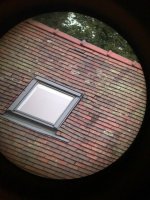Dipperdapper
Well-known member
Here we are: dioptre ring set to max positive travel

No sign of any flex or wobble in the bridge; very solidly built. Just tested under the stars; viewing through the binocular turned upside down flips the aberrations to the right-hand side of the image, just like the photo showed. It's possible to improve the edge of field appearance of the stars to a small extent but not entirely.

No sign of any flex or wobble in the bridge; very solidly built. Just tested under the stars; viewing through the binocular turned upside down flips the aberrations to the right-hand side of the image, just like the photo showed. It's possible to improve the edge of field appearance of the stars to a small extent but not entirely.
Last edited:



